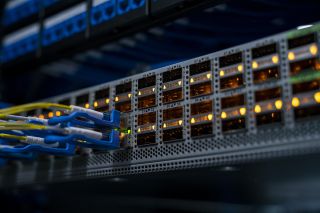The internet: History, evolution and how it works
The Internet is a massive computer network that has revolutionized communication and changed the world forever.

The internet is a vast network that connects computers across the world via more than 750,000 miles (1,200,000 kilometres) of cable running under land and sea, according to the University of Colorado Boulder.
It is the world's fastest method of communication, making it possible to send data from London, U.K. to Sydney, Australia in just 250 milliseconds, for example. Constructing and maintaining the internet has been a monumental feat of ingenuity.
What is the internet?
The internet is a giant computer network, linking billions of machines together by underground and underwater fibre-optic cables.These cables run connect continents and islands, everywhere except Antarctica
Each cable contains strands of glass that transmit data as pulses of light, according to the journal Science. Those strands are wrapped in layers of insulation and buried beneath the sea floor by ships carrying specialist ploughs. This helps to protect them from everything from corrosion to shark bites.
When you use it, your computer or device sends messages via these cables asking to access data stored on other machines. When accessing the internet, most people will be using the world wide web.

When was the internet invented?
It was originally created by the U.S. government during the Cold War. In 1958, President Eisenhower founded the Advanced Research Projects Agency (ARPA) to give a boost to the country’s military technology, according to the Journal of Cyber Policy. Scientists and engineers developed a network of linked computers called ARPANET.
ARPANET's original aim was to link two computers in different places, enabling them to share data. That dream became a reality in 1969, according to Historian Jeremy Norman. In the years that followed, the team linked dozens of computers together and, by the end of the 1980s, the network contained more than 30,000 machines, according to the U.K.'s Science and Media Museum.
How the onternet works
Most computers connect to the internet without the use of wires, using Wi-Fi, via a physical modem. It connects via a wire to a socket in the wall, which links to a box outside. That box connects via still more wires to a network of cables under the ground. Together, they convert radio waves to electrical signals to fibre optic pulses, and back again.
At every connection point in the underground network, there are junction boxes called routers. Their job is to work out the best way to pass data from your computer to the computer with which you’re trying to connect. According to the IEEE International Conference on Communications, they use your IP addresses to work out where the data should go. Latency is the technical word that describes how long it takes data to get from one place to another, according to Frontier.

Each router is only connected to its local network. If a message arrives for a computer that the router doesn’t recognizse, it passes it on to a router higher up in the local network. They each maintain an address book called a routing table. According to the Internet Protocol Journal, it shows the paths through the network to all the local IP addresses.
The internet sends data around the world, across land and sea, as displayed on the Submarine Cable Map. The data passes between networks until it reaches the one closest to its destination. Then, it passes through local routers until it arrives at the computer with the matching IP address.
The internet relies upon the two connecting computers speaking the same digital language. To achieve this, there is a set of rules called the Transmission Control Protocol (TCP) and Internet Protocol (IP), according to the web infrastructure and website security company Cloudflare.
TCP/IP makes the internet work a bit like a postal system. There is an address book that contains the identity of every device on the network, and a set of standard envelopes for packaging up data. The envelopes must carry the address of the sender, the address of the recipient, and details about the information packed inside. The IP, explains how the address system works, whileTCP, how to package and send the data.
How do websites work?
Click the numbers on the following interactive image to find out what happens when you type www.livescience.com into your browser:
Internet speed and bandwidth
When it comes to internet speed how much data you can download in one second: bandwidth. According to Tom’s Guide, to surf the web, check your email, and update your social media, 25 megabits per second is enough. But, if you want to watch 4K movies, live stream video, or play online multiplayer games, you might need speeds of up to 100-200 megabits per second.
Your download speed depends on one main factor: the quality of the underground cables that link you to the rest of the world. Fibre optic cables send data much faster than their copper counterparts, according to the cable testing company BASEC, and your home internet is limited by the infrastructure available in your area.
Jersey has the highest average bandwidth in the world, according to Cable.co.uk. The little British island off the coast of France boasts average download speeds of over 274 megabits per second. Turkmenistan has the lowest, with download speeds barely reaching 0.5 megabits per second.
Additional resources
You can read more about the history of the internet at the Internet Society website. To discover how the Internet has changed our daily lives, read this article by Computing Australia.
Bibliography
- "Getting to the bottom of the internet’s carbon footprint". University of Colorado Boulder, College of Media, Communication and Information (2021).
- "The evolution of the Internet: from military experiment to General Purpose Technology". Journal of Cyber Policy (2016).
- "The Internet: Past, Present, and Future". Educational Technology (1997).
- "Three-Way Handshake". CISSP Study Guide (Second Edition) (2012).
- "Content Routers: Fetching Data on Network Path". IEEE International Conference on Communications (2011).
- "Analyzing the Internet's BGP Routing Table". The Internet Protocol Journal (2001).
- "The Internet of Tomorrow". Science (1999).
Sign up for the Live Science daily newsletter now
Get the world’s most fascinating discoveries delivered straight to your inbox.
Laura Mears is a biologist who left the confines of the lab for the rigours of an office desk as a keen science writer and a full-time software engineer. Laura has previously written for the magazines How It Works and T3. Laura's main interests include science, technology and video games.

